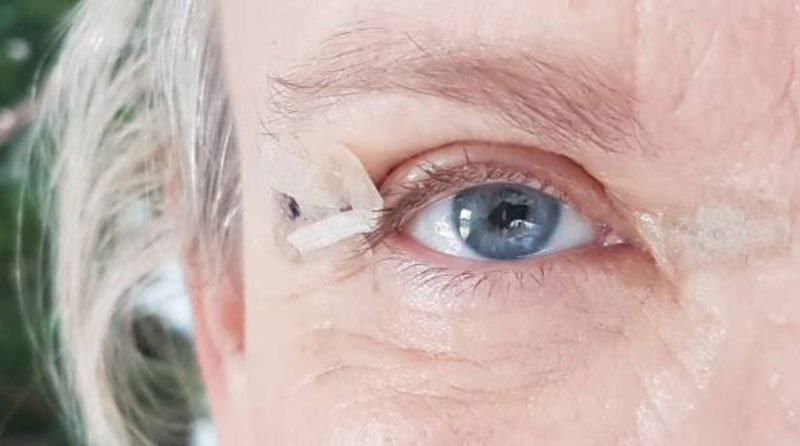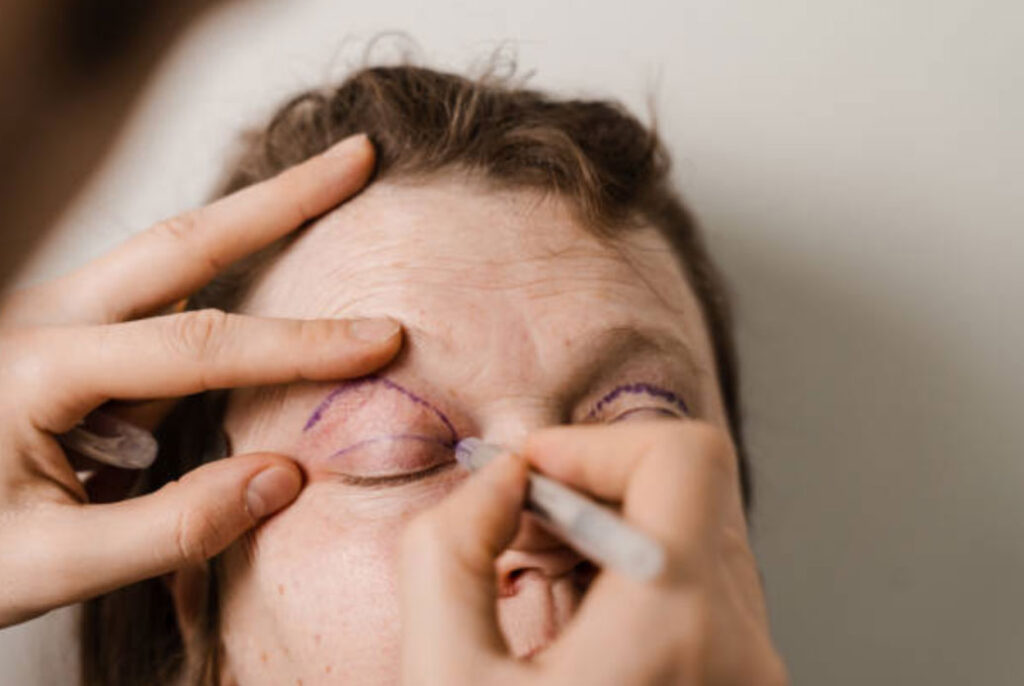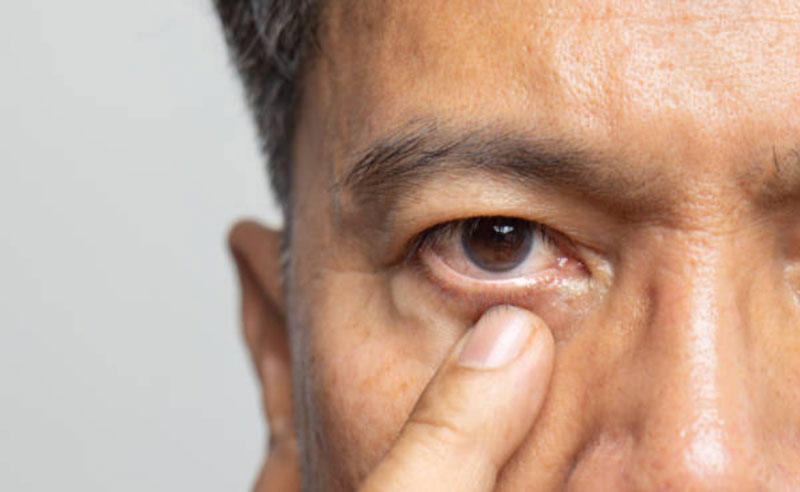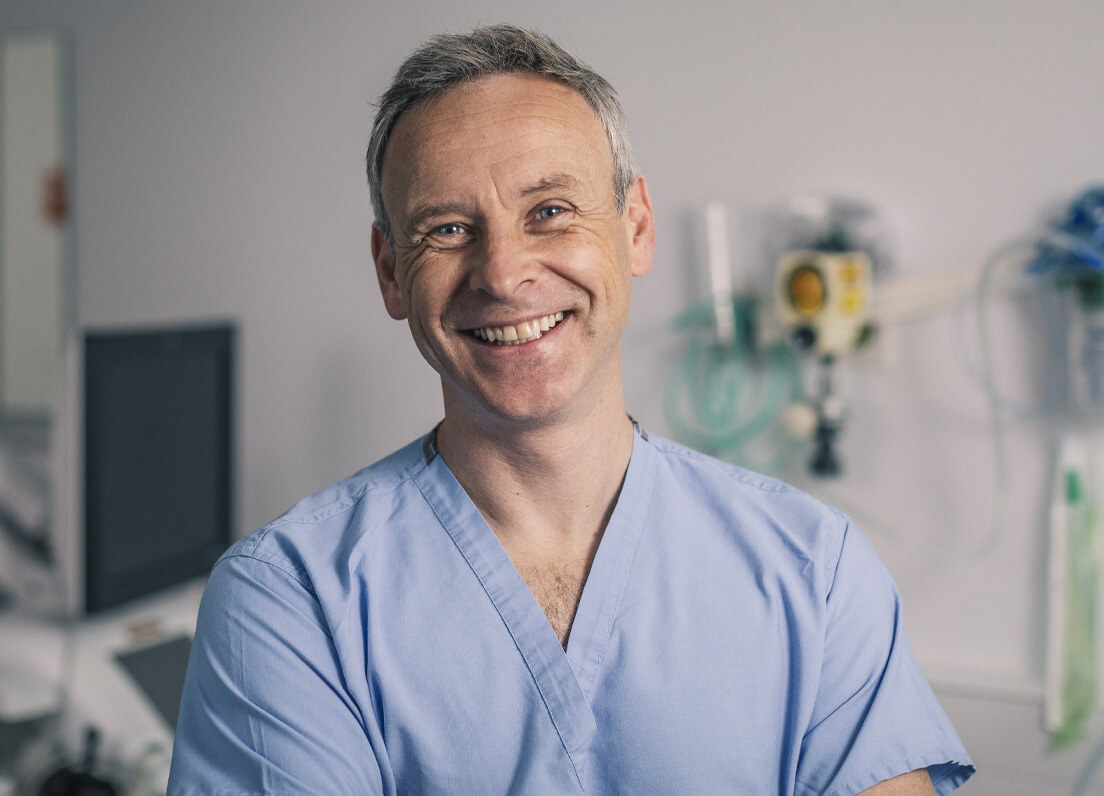Types of Blepharoplasty Stitches and How to Get Them Removed
The surgical term for a procedure that alters the appearance of the eyelids through removing excess skin or bulging fat is called a blepharoplasty.
The aim of a blepharoplasty is to improve the appearance of hooded upper eyelids or under-eye bags, giving your eye a fresher, brighter look.
In some cases, people opt for this surgery simply because they’re unhappy with the ageing process and the way it’s affecting their appearance. In other circumstances, the drooping skin can become so severe that it interferes with vision, making blepharoplasty a necessary procedure.
Whatever your reason for considering blepharoplasty, it’s important to understand what the procedure entails, and more importantly, what to expect during your recovery, including aspects related to stitches after blepharoplasty.
In this blog, Consultant Plastic Surgeon Anthony MacQuillan will give you more details about blepharoplasty stitches, the stitch removal process and tips for managing discomfort.
Types of Stitches Used in Blepharoplasty
In blepharoplasty, the choice of stitches (sutures) plays a pivotal role in both the healing process and the final cosmetic outcome. There are primarily two types of sutures used: absorbable and non-absorbable.
- Absorbable sutures are designed to naturally dissolve within the body over time. They are often used in cases where follow-up for suture removal might be challenging, or to minimise the stress of suture removal for the patient. These sutures are advantageous in that they reduce the need for a follow-up visit solely for stitch removal. However, the rate at which they dissolve can vary based on the individual’s body and the specific type of suture material used
- Non-absorbable sutures, on the other hand, are made from materials that do not dissolve. They can be preferred as there is no residual material left in the tissues and hence there is less inflammation within the tissues (potentially leading to a more favourable scar appearance sooner). Additionally, they tend to be stronger than their dissolving counterparts, however they do require a follow-up appointment for removal (this is usually a simple and quick procedure).
The choice between absorbable and non-absorbable sutures depends on several factors, including the specific requirements of the eyelid surgery, the patient’s skin type, and the surgeon’s preference based on experience and the desired outcome.
Care of Stitches Post-Surgery
Post-operative care of stitches is crucial for preventing infection and ensuring optimal healing.
- Keep the Area Clean: Gently clean the eyelid area as instructed by Anthony. This usually involves using a saline solution or a prescribed cleanser to gently dab the area
- Avoid Touching or Rubbing: It’s important to avoid rubbing the eyes or touching the stitches unnecessarily, as this can introduce bacteria and cause irritation
- Recognise Signs of Infection: Be vigilant for signs of infection, such as increased redness, swelling, pain, or discharge. If any of these symptoms occur, contact your surgeon immediately
- Follow Medication Guidelines: Use any prescribed antibiotic ointments or eye drops as directed. This helps in keeping the area sterile and promotes healing

Activities to Avoid with Stitches
During the period when stitches are still in place, it’s essential to take precautions and avoid certain activities to prevent damage or complications. Here are activities to avoid:
- Strenuous Exercise: Heavy lifting, intense workouts, and activities that increase blood pressure should be avoided during the initial recovery phase. These activities can result in a bleed from one of the blood vessels that has been cut during the operation – although sealed off by a clot with increased blood pressure the clot can be dislodged (like a cork popping out a of champagne bottle!) – which will cause a haematoma (collection of blood) in the surgical site which may have to be drained (meaning a trip back to theatre)
- Rubbing or Touching the Eyes: It’s crucial to refrain from rubbing or touching your eyes as much as possible. Rubbing can introduce bacteria to the surgical site and increase the risk of infection or irritation
- Wearing Eye Makeup: Avoid applying eye makeup or cosmetics to the surgical area until your surgeon gives you the green light. Makeup can introduce contaminants and increase the risk of infection
- Exposure to Sun and Wind: Protect your eyes from direct exposure to sunlight and wind during the initial recovery period. Wear sunglasses when you’re outdoors to shield your eyes from harmful UV rays and environmental irritants
- Wearing Contact Lenses: If you typically wear contact lenses, Anthony may recommend switching to eyeglasses temporarily during the recovery phase. Contact lenses can irritate the eyes and the general advice is to wear glasses only for 6 weeks following the procedure (your eyes will be more prone to dryness following surgery which the contact lens use will worsen).
Managing Discomfort from Stitches
Discomfort and irritation from stitches are common but manageable. Here are some tips:
- Pain Relief: Over-the-counter pain relievers like paracetamol (which is actually a fantastic analgesic) can be used to manage discomfort. Always follow the dosage instructions or Anthony’s recommendations
- Cold Compresses: Applying cold compresses can help reduce swelling and soothe the area. Make sure to wrap the compress in a clean cloth to avoid direct contact with the stitches. A Hilotherm machine can be rented post operatively (https://hilotherm.co.uk/rent-a-device__trashed/) which will provide optimal cooling to the eyes via a water cooled mask
- Avoid Itching: The area around the stitches may itch as it heals. Avoid scratching or rubbing. If itching is severe, consult Anthony, as he may recommend a mild steroid cream
- Sleeping Position: Sleep with your head elevated to reduce swelling. Try to sleep on your back to avoid putting pressure on the eyes
By following these guidelines, you can effectively manage your stitches post-blepharoplasty, ensuring a smoother and more comfortable recovery process.
Stitch Removal Process
The stitch removal process is a significant milestone in the blepharoplasty recovery. It’s a relatively straightforward procedure that usually takes place about a week after your surgery. While it’s understandable to feel a bit apprehensive about having stitches removed from your eyelid, rest assured that it is typically a painless and quick process.
Here’s what you can expect during the stitch-removal process:
- Timing: Typically removal of stitches from eyelids takes place at around the one-week mark after surgery, but the exact timing can vary depending on your surgeon’s preference and your specific case. If you have dissolving sutures they can be left but as the lid skin is so thin even with the very fine sutures I use (about the thickness of a hair!) they tend to hang around and so generally I book patient in to have them removed (but this can be anywhere beyond one week following surgery).
- Location: The stitch removal is performed in the outpatient department (either by me or one of the senior cosmetic nurses at Sulis Hospital).
- The Removal Process: Removing the sutures is easy and should be painless. Gently hold the end of the suture and cut the knot off (because they are very fine dissolving stitches the buried part of the suture can stay where it is). If you have had a lower lid blepharoplasty then you are likely to have at least one non dissolving suture on either side in which case one side of the stitch loop is cut and the stitch is pulled out (this can produce a mild sting).
- Sensation: While the thought of having stitches removed from your eyelid might sound uncomfortable, most patients report that it’s a painless process. You may feel a slight tugging or pulling sensation as each stitch is removed, but it is generally not painful.
- Aftercare: Once all the stitches have been successfully removed, Anthony will clean the area around the eyelids and may apply a soothing ointment to promote further healing and comfort.
It’s important to note that while stitch removal itself is not painful, the sensation can vary from person to person. Some individuals may experience slight discomfort, while others may hardly feel anything at all. The process is usually swift and is often described as a relief because it marks the beginning of the next phase of recovery.

What to Expect After Stitch Removal
After the stitches have been removed, you’ll enter a new phase in your blepharoplasty recovery journey. Here’s what you can expect in the days and weeks following stitch removal:
- Continued Healing: The removal of stitches signifies that Anthony believes your eyelids have healed sufficiently to continue the recovery without external support. Your body will continue to heal and adapt in the coming weeks
- Reduced Tension: Without the presence of stitches, you may notice a reduction in tension around the surgical area. This can contribute to increased comfort and a more natural feeling
- Sensation Changes: You might experience temporary changes in sensation around your eyelids. This can include mild numbness, tingling, or sensitivity. These sensations are normal and should gradually resolve as healing progresses
- Swelling and Bruising: While most of the initial swelling and bruising subside within the first week or two post-surgery, some residual swelling may persist. This is normal and should continue to improve over time
- Scar Management: If you have any concerns about scarring, discuss scar management options with Anthony. He may recommend scar creams or silicone gel sheets to help minimise the appearance of scars
- Follow-Up Appointments: It’s important to continue attending your scheduled follow-up appointments with your surgeon. These appointments allow Anthony to monitor your progress, address any concerns, and ensure that you are healing as expected
- Gradual Return to Normal Activities: Your surgeon will provide guidance on when you can resume various activities, such as wearing makeup, engaging in physical exercise, and exposing your eyes to the sun. It’s essential to follow his recommendations to support a smooth recovery
It’s important to remember that the healing process varies from person to person, and patience is key. While some individuals may see significant improvements within a few weeks, it can take several months for the final results of blepharoplasty to become fully apparent. Be diligent in following Anthony’s aftercare instructions, and if you have any concerns or questions during this phase of recovery, don’t hesitate to reach out to your medical team for guidance and reassurance.
Potential Complications Related to Stitches
While stitches are essential for proper wound closure and healing, there are potential complications associated with them. It’s important to be aware of these complications and how they are managed:
- Allergic Reactions: In some cases, individuals may develop an allergic reaction to the suture material. Symptoms can include redness, itching, swelling, or a rash at the site of the stitches. If you suspect an allergic reaction, contact your surgeon promptly. He or she may recommend an alternative suture material or treatment for the allergic reaction
- Infection: Infection at the surgical site is a rare but serious complication. Signs of infection can include increased redness, swelling, warmth, pain, and discharge. If you suspect an infection, contact your surgeon immediately. Treatment involves antibiotics and possibly removal of the infected stitches
- Suture Granulomas: In some cases, the body’s immune response can lead to the formation of suture granulomas, which are small, raised bumps or nodules at the site of the stitches. Anthony can address this issue by either monitoring the granulomas or, in some cases, removing them
- Suture Extrusion: Occasionally, a suture may become visible or extrude through the skin. This can be uncomfortable or unsightly. If this occurs, contact Anthony for guidance on how to manage it (it is likely that suture will simply be removed and the area will heal by itself)
- Scarring: While the goal of blepharoplasty is to minimise scarring, individual healing responses can vary. Some individuals may develop more noticeable scars than others. If you are concerned about scarring, discuss scar management options with your surgeon
It’s essential to keep in mind that complications related to stitches are relatively rare in blepharoplasty. Anthony takes precautions to minimise the risk of these issues, and careful monitoring and prompt intervention can address most complications effectively. Regular follow-up appointments with Anthony are crucial to monitor your healing progress and address any concerns promptly.

FAQs about Blepharoplasty Surgery
How long do you have to rest after blepharoplasty?
- After undergoing blepharoplasty (eyelid surgery), it’s generally recommended to rest for about 7 to 10 days. During this period, it’s important to avoid strenuous activities and any tasks that could strain the eyes. Resting not only aids in the healing process but also helps in reducing swelling and bruising around the eyes. Anthony will provide specific guidelines based on your individual surgery and recovery progress. It’s crucial to follow these instructions and attend follow-up appointments to ensure a smooth recovery.
When can I sleep on my side after eyelid surgery?
- Sleeping on your side after blepharoplasty should be avoided for at least 1 to 2 weeks post-surgery. It’s recommended to sleep with your head elevated and on your back to reduce swelling and avoid putting pressure on the eyes. This position helps in preventing unnecessary stress on the surgical area and aids in a smoother healing process. Anthony will advise you when it’s safe to resume sleeping on your side based on your recovery.
Can I shower with stitches on my eyelid?
- You can shower after blepharoplasty, but avoid direct shower jets hitting the area, likewise do not rub any soap (or other lotions) over the incisions. Clean running water over the area is ok but ideally keep the incisions dry if possible for the first week following surgery.
Can I watch TV after eyelid surgery?
- Watching TV after eyelid surgery should be limited, especially in the first few days following the procedure. Staring at screens can cause eye strain and dryness, which may hinder the healing process. It’s advisable to avoid activities that require intense focus or cause eye fatigue, including watching TV, using a computer, or reading, for at least a few days post-surgery. Gradually, as your recovery progresses and with Anthony’s approval, you can resume these activities.
How long do eyes water after blepharoplasty?
- Watery eyes are a common side effect after blepharoplasty and can last for several weeks post-surgery. This is often due to temporary changes in tear film distribution or irritation from the surgery. Most patients find that this symptom gradually diminishes as the healing process progresses. However, if excessive tearing persists or is accompanied by other symptoms like severe pain or vision changes, it’s important to contact your surgeon for advice. Regular follow-up appointments are essential to monitor your recovery and address any concerns. You will be asked to put eye drops in regularly for 2 weeks following the surgery (occasionally for longer in certain cases) and put ointment in your eyes at night – this is really important to adhere to as it will help to prevent you developing problems with the cornea (such ulceration) and is designed to provide a substitute tear film whilst your natural one is temporarily depleated.
Further Reading about Face Procedures with Consultant Plastic Surgeon Anthony MacQuillan
- Read more about Facelift Surgery Page
- Read more about Eyelid Surgery Page
- Read more about Ear Correction Surgery Page
- Read more about Top Tips to Sleep Better After Facelift Surgery
- Read more about Visible Effects of Ageing That Can Be Improved With a Facelift


